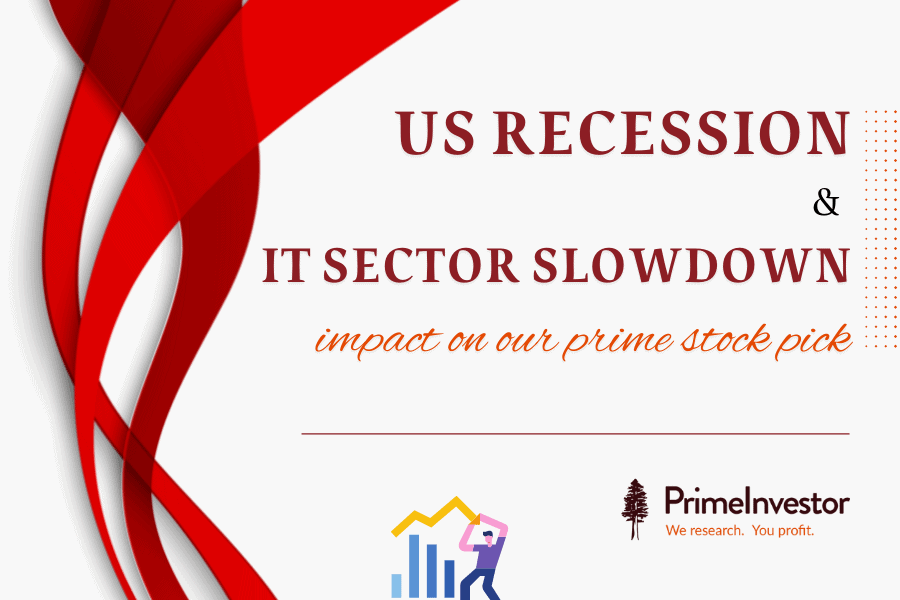Will the Indian IT sector slowdown as a result of a looming recession in the US? This is the question that many of you have asked us on the back of a sharp 32% correction in the Nifty IT index from its peak in January 2022. The next question is whether our ‘buy’ on one of the IT stocks is valid now and whether the same can be accumulated. We will try to answer these questions here.

Our call
We had recommended a buy on the stock of Infosys at Rs 1394 on January 14, 2021. It rallied to a peak of Rs 1940 (up 39%) and is now close to our buy price (at the time of this report). From its peak since our call, it is down 28%.
- If you bought the stock at our buy price, continue to hold it. We explain why you can, later in this report.
- If the stock tanks by 10-15% or more from our buy price (low probability), you can consider adding more.
- If you bought the stock around or above Rs 1,600 (15% over our original buy price), you can start averaging now if you have some surplus. But this has to be done in 2 phases and not in a single shot to provide room for any further correction.
We will now explain our stance on why the stock continues to be a buy.
IT sector slowdown?
After a bumper rally in 2020 and 2021 (Covid effect), the IT sector has been viewed with caution since the start of 2022, with talk of the US moving to a possible recession. Since the US is among the largest markets for Indian IT companies, the fear is that a slowdown in the US can cause a cut in discretionary IT spending by companies there. This in turn can harm project pipelines or pricing and margins for IT companies.
The market’s concern was reflected in IT stocks falling across board since January 2022. However, this seemed to stabilise post the June quarter results as some of the large players either brushed aside any serious recession concerns or demonstrated confidence through their guidance numbers. Infosys, for example, forecasted a 14-16 percent annual revenue growth for FY-23 (from 13-15% given in the previous quarter), in its June 22 quarter call.
However, such confidence was exuded when the recession fears were not as high as now. Presently, the US has shown all signs of moving into a recession, by most economic indicators, save for a strong labour market. According to surveys, a majority of the economists believe that the US is headed for a recession by mid-2023. These recent developments have once again caused IT stocks in India to plummet.
What is a recession?
How does one determine if the US is into a recession? There is no formal definition for an economic recession. According to the National Bureau of Economic Research, recession is “a significant decline in economic activity that is spread across the economy and that lasts more than a few months”. So that is loose enough to debate on whether there is a recession or not in the US.
But economists often view two consecutive quarters of negative GDP growth as a recession. Seen in this angle, the US economy is technically in a recession as its GDP dropped marginally both in the first and second quarters of calendar 2022.
In May 2022, after FY-22 results, we wrote on why IT stocks were correcting. Post that, the IT sector did stabilise like we had mentioned in the report. However, in light of the fresh set of concerns, the market will now watch for management calls and guidance of the large players of the September 22 quarter. It is quite possible that the confidence shown earlier in June 2022 may weaken a bit.
If this be the case, should we continue to maintain a ‘buy’ on the stock of Infosys? Here are reasons why we will.
#1 Tech spending during slowdown
We don’t think there is much of a debate on whether the US is headed for a recession or not. There is a slowdown of sorts, as key economic indicators clearly point out. What is debatable at this juncture is whether such a slowdown will end soon – a soft landing as they call it – or prolong and hit the US economy harder. As Indian markets remain most concerned about tech spending during a slowdown, let us see how recession spending has been in the space historically.
First, the recovery of global IT spending, post a slowdown, has been quite sharp. According to a report by Bernstein, during the global financial crisis, IT spending reduced by 7% in 2009 but recovered to 9.4% by 2010. Similarly, during Covid, IT spend declined by 1.6% but bounced back to a strong 7.5% in 2021. This is not only suggestive of a quick recovery in IT spends but also indicates that much of the spend has become necessary rather than just discretionary.
It is also important to understand the quantum of growth of IT companies even from a marginal increase in IT spends. After the global financial crisis, for instance, global IT spend (according to the report) was at an average 2-3% between 2010-15 but Indian IT companies managed an average 13.2% growth (worst being 10.2%). This points to low spending still spurring double digit growth during periods of slowdown.
What is further interesting is that Infosys and TCS have a record 30% of the market share among the top 7 IT companies in India. And interestingly, their combined market share has risen from 11% in 2006 to 30% by 2021 with much of the market share gain happening post financial crisis. Accenture, in the same period, lost share from 65% to 37% now. Flexible pricing and shift in nature of services that India-based IT companies offer have helped them gain market share post a slowdown.
Hence, we think that markets may be somewhat underestimating the resilience of large IT companies, in the event of a recession.
#2 Large deals and nature of deals to provide support
Infosys has been growing at a faster pace than TCS over a few quarters now (year-on-year growth) as data below will suggest. This has been possible from robust deal pipelines.
This pace of growth could certainly slow down for a few quarters. However, for the company to achieve the 15-16% top line guidance for FY-23, it has to grow at 3% sequentially for the next 3 quarters. We think this is not a very difficult ask given that the deal momentum has been good for the company.
Two factors hold Infosys in a better position - the large size of its deals and therefore the longer length of such projects. These factors make companies such as Infosys more resilient to a downturn as opposed to those with shorter projects (6-9 months) that typically dry up during a recession. Infosys’ total contract value (TCV) of large deals was $1.7 billion for the quarter ending June 2022. This accounted for 50% of net new deals. Data below shows how the company has been steadily increasing the TCV of large deals over the quarters now.
Infosys as well as larger players have continued to benefit from cloud/digital transformation projects as well as higher outsourcing spend. Revenue from their digital offering was 61% of June 22 quarter revenue as opposed to 53% in the June 21 quarter. Digital offerings tend to enjoy better pricing and margins and this is perhaps one reason why Infosys, in its guidance in June 2022, stated an EBIT range of 21-23%. Even if this guidance cannot be achieved, we think higher digital offerings can provide reasonable support in a downturn.
#3 Normalising margins and normalising valuation
Most of the large IT companies that saw a surge in EBIT margins due to Covid have seen margins normalising. Cost pressures including sub-contracting cost, salary hikes, and upfront hiring impacted Infosys in the past 2 quarters. While some of these pressures are seasonal and may abate, we do see normalising of margins post Covid.
Pressures such as wage inflation and subcontracting costs can last longer. What can help absorb some of this pressure and support margins are levers such as high offshore effort (maintained at around 76% for June 22 and Jun 21 quarters), ability to price better in digital deals, and higher utilisation (which had reduced to 85% in June 22 quarter) as more freshers get billed.
If this be the case, then stability in margins along with a PE that is now at a 3-year average of 26 times makes the stock an attractive bet. Do note that more larger deals, higher digital revenue all called for a re-rating between 2020-22. Infosys is now at a 31% discount from its peak valuation on Dec-21. The stock also remains at an 8% discount to TCS in terms of price-earnings ratio.
Therefore, continue to hold Infosys. Accumulate if you had bought the stock above Rs 1600.








13 thoughts on “US recession and IT sector slowdown – impact on our stock pick”
What is Primeinvestor view on ITBeES. Reliance ETF I mean. Is it not good to add directly as proxy to IT index and available with Live tracking during market hours. Let me know. I started some tracking position as its trading at low levels as overall sector is down. Your suggestion will be helpful.
Regards
Nitin Pathak
We have a call in our Prime ETFs on this sector. You can check the same. On the sector itself, we recently covered it during one of our stock reviews (for growth susbcribers): https://www.primeinvestor.in/us-recession-and-it-sector-slowdown-impact/
Vidya
Hi Mam, Can we expect any new stock recomendation from IT sector. as we have only one rigjt now.
We are evaluating a few stocks but are waiting for valuations to correct.
Thank you, mam.
Thanks for a timely note.
Given the scenario, would PrimeInvestor suggest a tactical buy call on the IT index with say, a 2 – 3 year horizon ?
You will receive our mail, if and when we do. thanks, Vidya
you dint mention anything about dollar effect.
That is a given sir. if the current weakeness persists that will also provide support. But we did not want to take a call based on that. hence refrained. Vidya
Hello ,
If someone has shares below the Prime recommended price what do we do? Should we look to add at these levels to average up upto the recommended price?
Thanks,
Ashish
If the share falls at least 10-15 percent below your buy price you can. Else, no meaningful averaging will happen.Unless of course you want to size up your holding. That’s something that cannot wait for steep correction.
What is the TO DO things for SIP in 2 IT Fund which are recommended in PRIME MF portfolio ?
We don’t usually recommend SIPs in sector funds. We prefer phased investments. But if you have one running, you can continue as the correction may last a bit. And it is not a portfolio. I hope you don’t hold both funds. Vidya
Comments are closed.